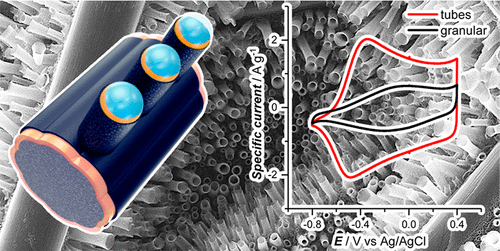当前位置:
X-MOL 学术
›
ACS Appl. Mater. Interfaces
›
论文详情
Our official English website, www.x-mol.net, welcomes your
feedback! (Note: you will need to create a separate account there.)
Condensing Vapor Phase Polymerization (CVPP) of Electrochemically Capacitive and Stable Polypyrrole Microtubes
ACS Applied Materials & Interfaces ( IF 8.3 ) Pub Date : 2017-11-15 00:00:00 , DOI: 10.1021/acsami.7b13874 Luciano M. Santino 1 , Erica Hwang 1 , Yifan Diao 1 , Yang Lu 1 , Hongmin Wang 1 , Qisheng Jiang 1 , Srikanth Singamaneni 1 , Julio M. D’Arcy 1
ACS Applied Materials & Interfaces ( IF 8.3 ) Pub Date : 2017-11-15 00:00:00 , DOI: 10.1021/acsami.7b13874 Luciano M. Santino 1 , Erica Hwang 1 , Yifan Diao 1 , Yang Lu 1 , Hongmin Wang 1 , Qisheng Jiang 1 , Srikanth Singamaneni 1 , Julio M. D’Arcy 1
Affiliation

|
We introduce a novel condensing vapor phase polymerization (CVPP) strategy for depositing microtubes of the conducting polymer polypyrrole; these serve as one-dimensional hollow microstructures for storing electrochemical energy. In CVPP, water droplets are structure-directing templates for polypyrrole microtubes. Water vapor condensation and polymerization occur simultaneously—conformal coatings of microtubes deposit on porous substrates such as hard carbon fiber paper or glass fiber filter paper. A mechanistic evolution of the microtubular morphology is proposed and tested based on the mass transport of water and monomer vapors as well as on the reaction stoichiometry. A coating of PPy microtubes is characterized by a high reversible capacitance of 342 F g–1 at 5 mV s–1 throughout 5000 cycles of cyclic voltammetry and a low sheet resistance of 70.2 Ω □–1. The open tubular structure is controlled in situ during synthesis and leads to electrodes that exhibit electrochemical stability at high scanning rates up to 250 mV s–1 retaining all stored charge, even after extensive cycling at 25 mV s–1.
中文翻译:

电化学电容稳定的聚吡咯微管的冷凝气相聚合(CVPP)
我们介绍了一种新型的冷凝气相聚合(CVPP)策略,用于沉积导电聚合物聚吡咯的微管。这些用作存储电化学能量的一维中空微结构。在CVPP中,水滴是聚吡咯微管的结构导向模板。水蒸气冷凝和聚合同时发生-微管的保形涂层沉积在多孔基材(例如硬碳纤维纸或玻璃纤维滤纸)上。提出并基于水和单体蒸气的传质以及反应化学计量对微管形态的机理进行了演化和测试。PPy微管涂层的特点是在5 mV s –1时具有342 F g –1的高可逆电容在5,000次循环伏安循环中,其薄层电阻为70.2Ω□ –1。开放的管状结构在合成过程中被原位控制,并导致电极在高达250 mV s –1的高扫描速率下表现出电化学稳定性,即使在25 mV s –1的广泛循环后仍保留所有存储的电荷。
更新日期:2017-11-16
中文翻译:

电化学电容稳定的聚吡咯微管的冷凝气相聚合(CVPP)
我们介绍了一种新型的冷凝气相聚合(CVPP)策略,用于沉积导电聚合物聚吡咯的微管。这些用作存储电化学能量的一维中空微结构。在CVPP中,水滴是聚吡咯微管的结构导向模板。水蒸气冷凝和聚合同时发生-微管的保形涂层沉积在多孔基材(例如硬碳纤维纸或玻璃纤维滤纸)上。提出并基于水和单体蒸气的传质以及反应化学计量对微管形态的机理进行了演化和测试。PPy微管涂层的特点是在5 mV s –1时具有342 F g –1的高可逆电容在5,000次循环伏安循环中,其薄层电阻为70.2Ω□ –1。开放的管状结构在合成过程中被原位控制,并导致电极在高达250 mV s –1的高扫描速率下表现出电化学稳定性,即使在25 mV s –1的广泛循环后仍保留所有存储的电荷。











































 京公网安备 11010802027423号
京公网安备 11010802027423号